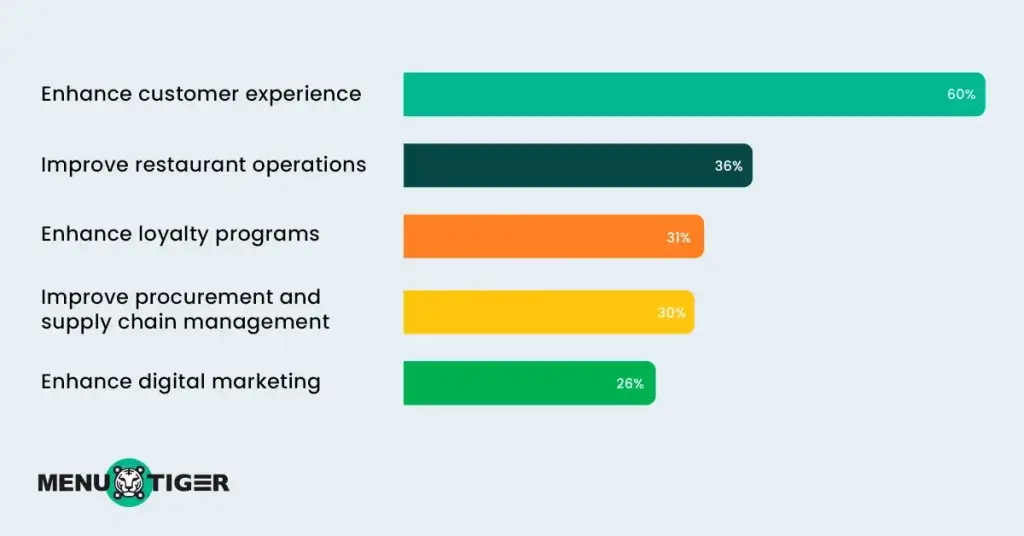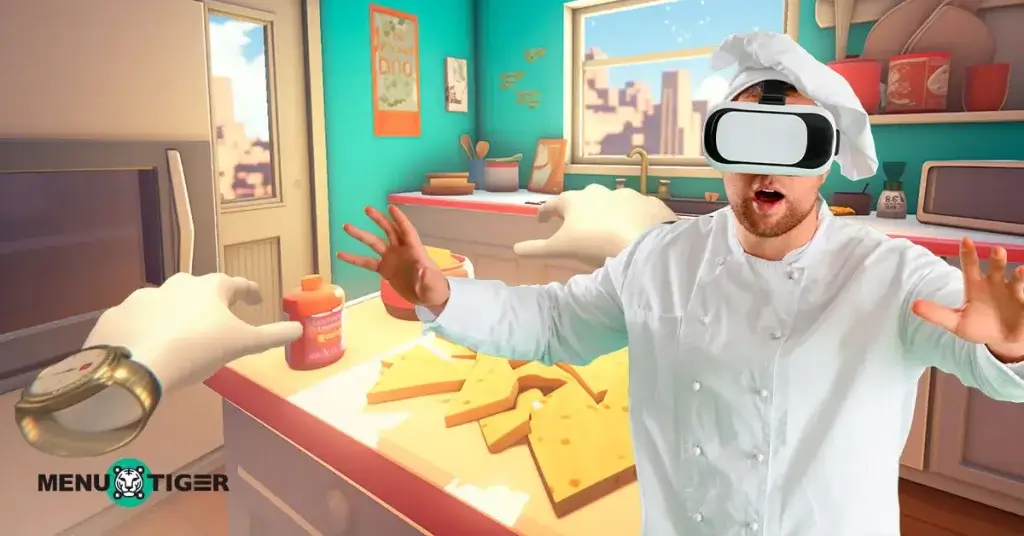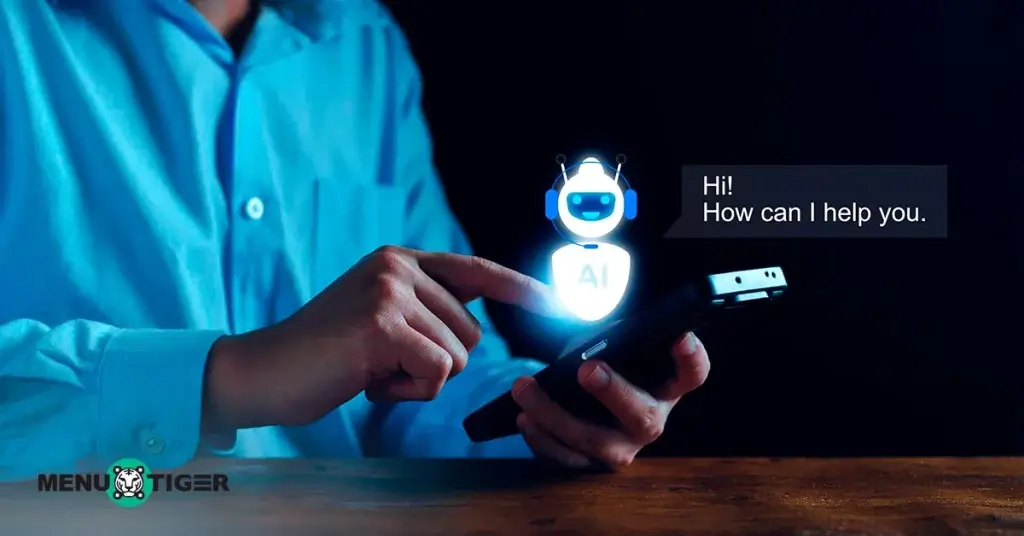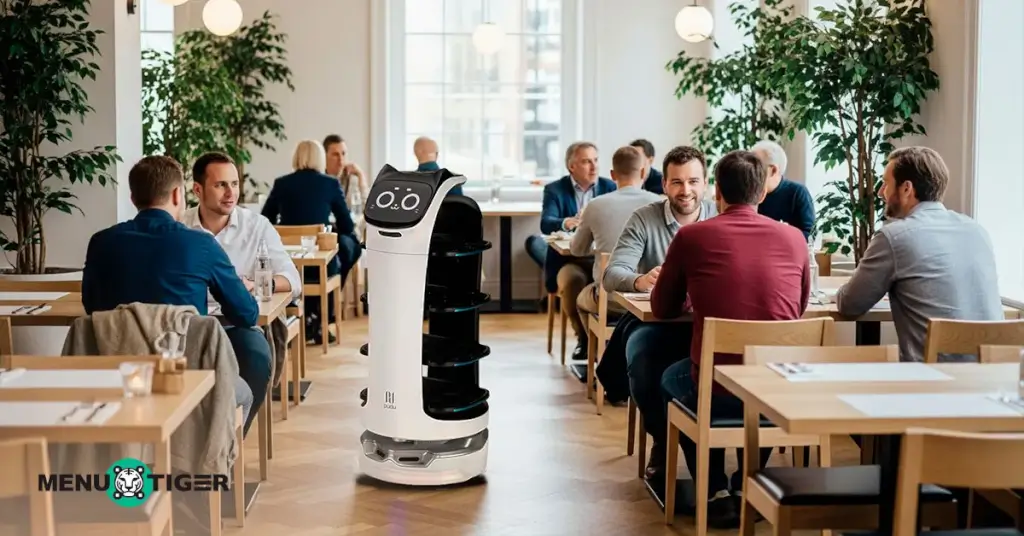AI for restaurants is evolving at lightning speed, and nowhere is this more visible than in China.
According to the South China Morning Post, Shanghai aims to become a global hub for “smart dining,” rolling out robot-run kitchens, robot servers, and AI-powered digital menus.
By 2028, the city plans to integrate these smart technologies into more than 70% of group dining and fast-food operations.
Today, AI is transforming not just how people work, learn, and handle daily tasks, but also the very way we dine.
So it pays to ask, “Is AI really the future of dining?”
In this article, we explore how AI is reshaping restaurant operations and what it means for the future of the industry.
Table of Contents
ToggleWhat does AI for restaurants even mean?
AI for restaurants is the integration of Artificial Intelligence (AI) into all aspects of operations and customer interactions.
Its core function is to allow AI systems to replicate human-like intelligence, but with the ability to process massive amounts of data in real time to automate tasks, predict outcomes, and provide hyper-personalized service.
Instead of hiring a person to handle all the tough jobs, the restaurant is given a smart digital brain that makes operations faster and more accurate than a person can.

The rise of AI in the restaurant industry: Data and statistics

According to Deloitte’s research titled “How AI is Revolutionizing Restaurants,” 375 restaurant executives from 11 countries participated in a survey on AI usage.
The results show that about 73% plan a moderate increase in investment in AI technologies, while 9% are preparing for a significant boost.
With very few planning to spend less, it is clear that restaurants are prioritizing major investments in artificial intelligence within the industry.
Why is there a high investment in AI for restaurants?
Restaurant executives highlight their hopes for AI efforts. From the 375 respondents, these are the top five responses, particularly related to customer experience and operational improvements:

7 AI technologies that will shape modern restaurants
Here are seven AI technologies that are changing the way restaurants run and serve their customers, from the kitchen all the way to the dining table:
1. AI-Powered restaurant management systems
Restaurant management software centralizes several key operations: order processing, scheduling, inventory tracking, and data analysis.
AI studies historical sales and real-time patterns to predict busy periods, ingredient and staffing needs.
Managers will gain accurate insights that help them avoid shortages, prevent overscheduling, and maintain hassle-free operations throughout the day.
2. Robot staff
Modern service robots use AI, computer vision, and advanced navigation to move around the dining area with accuracy. They can deliver dishes to tables, return used plates to the kitchen, and assist with basic service tasks.
By taking over repetitive and physically demanding work, robots allow human staff to focus on hospitality, upselling, and handling situations that require empathy or problem-solving.
3. Augmented and Virtual Reality (AR/VR)

Virtual Reality (VR) is becoming a valuable training tool; one example is KFC’s hard way training escape room. It lets new employees step into a virtual kitchen where they can practice procedures, learn equipment, and make mistakes without real-world consequences in a fun way.
Augmented Reality (AR) tools, on the other hand, show 3D models of dishes. Diners can see portion sizes, plating, and ingredients before ordering, which helps reduce uncertainty and improves overall satisfaction.
4. Automated kitchen equipment
Automated kitchen equipment uses AI to monitor and control the whole cooking processes. These systems can track cooking times, temperatures, and ingredient portions.
For example, fryers, grills, and ovens can operate autonomously while ensuring food meets exact specifications.
The result is faster service, minimized food waste, consistent quality, and the ability for kitchen staff to focus on plating and quality control.
5. Chatbots for reservations and customer service

Chatbots automate communication between restaurants and customers across multiple channels, including websites, apps, and messaging platforms.
They handle reservations, answer common customer questions, and offer recommendations based on menu updates or promotions.
This reduces pressure on the front-of-house team, allowing staff to focus on in-person guests and handle more complex inquiries.
6. Intelligent supply chain systems
AI supports the entire supply chain by tracking ingredient levels, estimating when supplies will deplete, and analyzing which products tend to run out quickly.
It can identify patterns that humans might miss, such as seasonal spikes or waste-related issues. This helps restaurants maintain consistent stock, reduce spoilage, and ensure menus stay available without interruptions.
7. Smart delivery system
AI optimizes the delivery process by assigning drivers, selecting the most efficient routes, and providing real-time updates to customers.
Some smart restaurants are even testing autonomous delivery robots that navigate sidewalks or short distances independently.
One example is Robomart, one of the cheapest food delivery apps that works like a mini store on wheels. It uses AI to drive itself, tracking which items customers take with smart sensors.
These systems reduce delivery times, improve accuracy, and help restaurants handle high order volumes more efficiently.
5 restaurants that use smart AI technologies
Restaurant technology is entering a transformative era, with AI reshaping everything from frontline service to behind-the-scenes operations in unexpected, future-leaning ways:
1. Deny’s Bellabot
Deny’s, a family diner restaurant, has been using an AI-powered robot server called BellaBot. Bella has multi-tray delivery, navigation system, touchscreen interface, and AI voice interaction.
Their main purpose of using robots is to provide support to the waitstaff, enhance customer interaction, and boost foot traffic.
Since Denny’s introduced the robot, service efficiency has improved, staff workload has been reduced, and customer interaction has increased, as some customers choose Denny’s specifically to interact with Bella.
The robot positively impacts both staff performance and overall restaurant operations.
2. Wendy’s drive-thru ordering system
Wendy’s is exploring a new way to handle drive-thru orders by allowing an AI system called FreshAI to manage the interaction.
The AI handles most of the ordering on its own, successfully processing about 86% of transactions within 22 seconds without staff involvement.
Customers will not see a major change in how they order, but the voice assisting them will belong to an AI system rather than a crew member.
According to Wendy’s statement, while the system reduces human intervention in order taking, it does not replace staff. Instead, it allows them to focus on preparing high-quality food.
With the early numbers looking positive, Wendy’s believes that the system will continue to get better as the technology evolves.
3. Yum’s restaurant management system
Yum!, the global restaurant group behind KFC, Taco Bell, Pizza Hut, and Habit Burger and Grill, has rolled out an AI-powered platform called Byte by Yum! to make running its restaurants a whole lot easier.
The platform brings together everything from online and mobile ordering to point-of-sale systems, kitchen and delivery tools, menu management, and even labor scheduling, basically creating a seamless, all-in-one digital system for franchisees.
AI isn’t doing the cooking or taking orders (yet), but it’s guiding the team, planning tasks, and optimizing workflows, which is what “team productivity” refers to in this system.
4. CaliExpress smart kitchen
Restaurants like CaliExpress by Flippy in California have adopted Flippy to handle high-volume cooking tasks.
Flippy, from Miso Robotics, is an AI-powered robot that helps out in the kitchen by handling the fry and grill stations.
The AI system uses computer vision and machine learning to monitor cooking times, detect when food is done, and adjust in real-time, ensuring consistent quality.
5. KFC’s facial recognition kiosk
According to research from Forth, unlike normal self-serve kiosks or the AI menus that identify users through accounts, email addresses, or browser data, KFC’s kiosks rely on facial recognition to gather insights.
The system can pick up details such as estimated age, gender, and even mood cues. This information helps tailor the menu display and recommendations to the individual viewing the screen.
The kiosk suggests items based on what the customer has ordered before. These suggestions typically reflect recent choices and personal favorites.

The impact of adopting AI in the restaurant industry
AI is a tool that will accelerate whatever goals we set for it. So, as a restaurant owner, it is important to understand the negative and positive implications of AI dining.
Here’s how people perceive AI and its impact on the world:
Positive implications:
- Smart and faster service. According to QRS Magazine, AI and robotics increase efficiency by 30%. This boost comes from handling routine tasks and freeing staff for higher-value work.
- Better food waste management. Research from Brown Bacon AI found that 34% of restaurants improved inventory control, in part because AI predicts shortages and overstock.
- Lower labor costs. Data from ZipDo shows AI tools can reduce labor costs by 20% by automating routine tasks.
- Increase sales and revenue. Insights from Brown Bacon AI indicate that 37% of restaurants saw an increase in sales and revenue after adopting AI solutions.
- Accurate customer demands. WiFiTalents shows that AI-powered predictive analytics can forecast demand with approximately 85% accuracy.
Negative implications:
- Cause potential job loss. According to Loman.ai, experts warn that 10–80% of restaurant jobs are at risk, especially in roles with repetitive tasks like order-taking or food prep.
- Raise data security and privacy concerns. A report by Restobiz says that in 2025, over 30% of hospitality businesses experienced at least one cyberattack, with breach costs averaging around US$3.4 million.
- Loss of human service. Findings from Business Wire reveal that 41% of diners are concerned about losing personal interaction as AI becomes more common.
- Technical challenges. According to Scribd, 17.2% of restaurant operators face barriers. These challenges often include system integration issues and staff training, which can slow down implementation and reduce efficiency
- Trust issues in safety. According to Restaurant Business Online, 39% of consumers would not trust AI to handle dietary restrictions or allergies.
Bridging the gaps: How restaurant order management supports AI in restaurants

For AI to succeed, it needs a digital framework to cover its blind spots. AI is a genius integration, but the restaurant order management system is the one that gives them all the real-world context.
Here’s a breakdown of the AI’s limitations and how an advanced RMS steps in to save the day:
Menu management for AI chatbots
A chatbot on messaging apps or at the counters can promote new dishes and specials and suggest items to customers.
However, the AI is not designed to update the menu on its own, which helps ensure that all updates are accurate.
Menu management lets you add or change items on your menu, giving the integrated chatbot the information it needs to share and recommend these dishes to your customers based on the changes you made.
Data and analysis for AI forecast and inventory management
Restaurant management systems are designed to track which dishes are best-sellers, how many orders are placed, and what items are most frequently requested.
When integrated with AI, this data allows the system to forecast demand for each dish, predict how much of each ingredient will be needed, and help managers plan inventory more accurately.
This ensures that popular dishes are always available, reduces food waste in restaurants, and allows the kitchen to operate more efficiently during peak times.
Customers’ data for AI’s personalized offers
The restaurant order system collects customer information when they place an order, such as emails, names, contact numbers, and the dishes they choose.
This data is helpful for AI menus because it serves as the foundation for creating personalized offers and recommendations.
By analyzing past orders and customer preferences, AI can suggest dishes, promotions, or combos that are most likely to appeal to each individual.
Kitchen display system for an AI counter
When AI takes an order, it automatically sends the details to the kitchen display system (KDS). This ensures the kitchen staff know exactly what to prepare, reducing mistakes and speeding up service.
By connecting AI with the KDS, restaurants maintain accuracy and efficiency from order placement to delivery.

So, are you ready for the future of dining?
The goal isn’t to build a fully automated restaurant run by cold technology. The most successful restaurants will use AI and robots as essential support systems.
The future of dining isn’t just AI. It’s a perfect blend of digital efficiency and human warmth. The integration of a robust restaurant management system with AI is the key to making this work, ensuring the smart brain has the accurate, real-world context it needs to deliver on its promises.
The shift is already happening. The only question remaining for restaurant owners isn’t if they will embrace AI, but how fast they will adapt to this smarter, more efficient way of serving the world.



